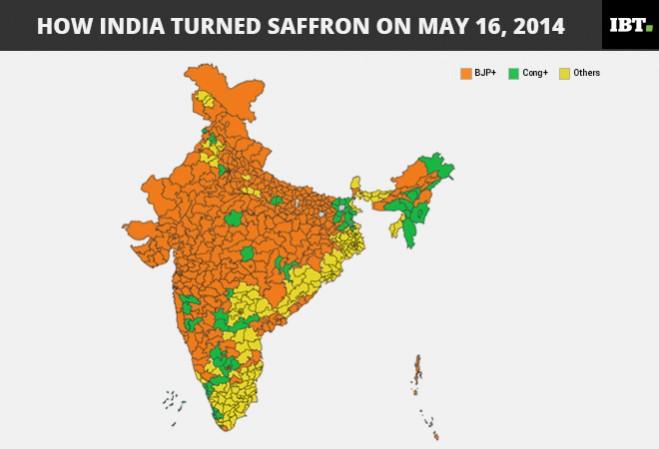
Not many had a surprise that Narendra Modi would win it but the way he bagged it stunned them all. As the day progressed on May 16, 2014, which was a Friday, the Bharatiya Janata Party (BJP) under the leadership of the then Gujarat chief minister Modi blew away each and every opponent that came on its way.
Also read: May 16, 2014: The day the Grand-Old Party saw its lowest point
The BJP's win was so emphatic in the 16th Lok Sabha election that it had made even its political alliance – the National Democratic Alliance (NDA) irrelevant by winning a majority by itself. Out of 543 seats in the Lower House of the Parliament, the BJP won 282 seats, exceeding its Mission 272+ by far. It was historic for many reasons.

Single-party majority after 30 years
First, it was after 30 long years that a general election in India produced a single-party majority. The last time it happened was in 1984 when the Congress, riding the sympathy wave generated by Indira Gandhi's assassination in October that year, bagged 415 seats! It is something the Congress did not achieve even during the days of Jawaharlal Nehru or Indira.
First non-Congress party to win majority in national election
Secondly, the BJP also created a record of becoming the first non-Congress party to win a majority in a national election. On every other occasion, it was only the Congress which had accomplished the feat of winning majority by itself [in 1952, 1957, 1962, 1967, 1971, 1980 and 1984].

NDA swept UP, won 73 of 80 seats in the state
Thirdly, the NDA felt just 10 seats short of equalling the Congress's sweeping Uttar Pradesh, India's most crucial political state, in 1984. While the Grand-Old Party won 83 out of 85 seats in the state, the NDA won 73 out of 80 seats in UP in 2014. It was also a vast improvement by the BJP in its tally in the state since 2009 when it could win just 10 seats. BJP president Amit Shah's counter-polarisation was seen as a major reason behind the sweep. Also, the BJP succeeded in winning over the Dalit votes to beat opponents like Mayawati of the Bahujan Samaj Party.
BJP won a national election after 15 years
Fourthly, the BJP won a national election after 15 years and it was a serious test for the party's new-age leadership in the post-Vajpayee and Advani era.
| BJP's tally in Uttar Pradesh in general elections between 1984 and 2014 | ||||||||
| 1984 | 1989 | 1991 | 1996 | 1998 | 1999 | 2004 | 2009 | 2014 |
| 0 (Out of 85 seats) | 8 (85 seats) | 51 (85 seats) | 52 (85 seats) | 57 (85 seats) | 29 (85 seats) | 10 (80 seats) | 10 (80 seats) | 71 (80 seats) |
The party's loss in the 2009 general elections under the leadership of Advani had left a serious impact on its future and the party earnestly hoped that it would be able to turn things around under Modi, who rose to prominence from mid 2012 onwards.

Had the BJP failed to make a difference from the previous two elections this time as well, history might not have been kind to it. But Modi did not allow doubt any chance in the Lok Sabha election of 2014. It had practically settled the question 'What after Vajpayee-Advani' question in no time.
| Tally of BJP in general elections after which BJP formed governments |
|
| 1996 [AB Vajpayee became PM for 13 days] | BJP won 161 seats |
| 1998 [AB Vajpayee became PM for 13 months] | BJP won 182 seats |
| 1999 [AB Vajpayee became PM for full term] | BJP won 182 seats |
| 2014 [N Modi became PM] | BJP won 282 seats |
That the emphatic victory of the BJP [prominent parties of the Hindi heartland like the BSP and RLD drew a blank in the Modi tsunami] was not a fluke was proved in the subsequent months as the saffron party came to power in a number of states for the first time [either as a senior ally as in Maharashtra or first-time ever in history as in J&K, Haryana and Assam].
They also came in power in Jharkhand, Uttarakhand and Uttar Pradesh and foxed the Congress in Goa and Manipur despite finishing after the latter in the Assembly polls early this year.
The BJP succeeded in opening its electoral account in Kerala for the first-time ever and producing the best show in West Bengal [three seats] in the post-Bharatiya Jana Sangh days. The BJP's disappointments came in Delhi and Bihar in 2015, Tamil Nadu and Puducherry in 2016 and Punjab in 2017.












